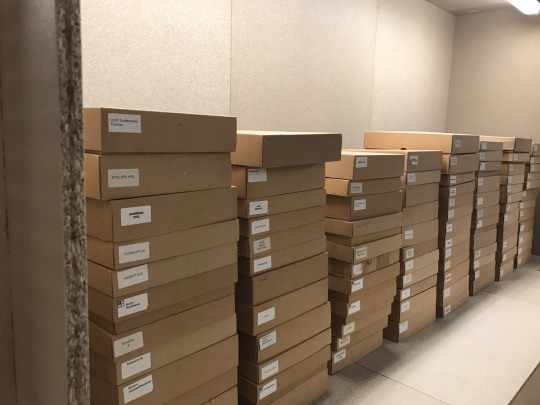#LUST LustLab digitalarchive
Text
From Analogue to Digital

Designers: Jeroen Barendse, Thomas Castro and Dimitri Nieuwenhuizen (LUST).
At first sight, the 3-storey structure in the middle of a big hall will make people think: where do I start? Following the stairs to the 3rd floor, visitors will be presented with archives, the starting point for designers, in the form of sketches, mock-ups and objects that inspired them. One floor down, visitors will see the next step: plans and prototypes. On the ground floor, visitors can browse through the end products displayed in what feels like a gallery.
My attention was drawn to the archive presentation of LUSTwork from the design studio LUST: rows and piles of brown boxes, each with a label indicating their contents. Those seemingly idle boxes represented something so much bigger, so substantial: the transition from analogue to digital, from boxes to bytes. As physical data was being digitized, the number of boxes will be smaller and smaller, while the digital data files grew larger and larger. As piles of analogue data are still waiting to be digitized, at the same time, more new data are constantly being produced—and stored. This made me wonder: will there ever be an end to this process, as new data is constantly being produced?
These boxes are so neatly piled and labeled, but in real life, pieces of data are stored and scattered in so many places, institutions and organizations, in so many different formats. We see filing cabinets in offices, boxes in warehouses and homes, all containing those pieces. This made me wonder: how many of them are lost, misplaced, or worse yet—forgotten?
In my home country, Indonesia, the tension between analogue vs. digital cannot be more palpable: the country is under pressure to be more efficient and transparent, hence the implementation of e-Government, e-ID Card, e-Filing of everything. But they struggle with infrastructure and human habits: the e-ID Card contains digital data, but it’s rendered useless because card readers are not available. So the card containing ‘digital’ data still needs to be photocopied and the paper copy stored in good old filing cabinets and boxes! And this paper-and-ink habit is so deeply ingrained, making it even more difficult to transition to digital.
The LUSTwork presentation is like a wake-up call, a reminder of the importance and necessity to transition from analogue to digital, as represented by the humble brown boxes which contain the source of all the digitized data… while the Speculative Design Archive shows how these data, source materials and other treasures could best be brought together, collected, safely housed and made accessible to the general public.
Archiving the past vs. designing the future. The tension is real. And the ‘race’ is never-ending.
- Nikita Zamzam


0 notes